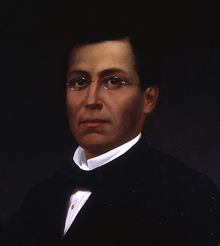Ignacio Zaragoza
| Ignacio Zaragoza Seguín | |
|---|---|
 General Ignacio Zaragoza | |
| Born |
March 24, 1829 Nuestra Señora de Loreto de la Bahia, Coahuila y Texas, |
| Died |
September 8, 1862 (aged 33) Puebla, Puebla, |
| Buried at |
Panteón de San Fernando Mexico City |
| Allegiance |
|
| Service/branch | Mexican Army |
| Years of service | 1853-1862 |
| Rank |
General Secretary of War |
| Battles/wars |
|
Ignacio Zaragoza Seguín (Spanish pronunciation: [iɣˈnasio saɾaˈɣosa]; March 24, 1829 – September 8, 1862) was a general in the Mexican army, best known for defeating invading French forces at the Battle of Puebla on May 5, 1862 (now celebrated in both the United States and Mexico as the Cinco de Mayo).
Biography

Zaragoza was born in the early Mexican Texas village of Bahía del Espíritu Santo (now Goliad, Texas, in the United States) in what was then the Mexican state of Coahuila y Texas. He was the son of Miguel G. Zaragoza and María de Jesús Seguín, who was a niece of Erasmo Seguín and cousin of Juan Seguín. The Zaragoza family moved to Matamoros, Mexico, in 1834, and thence to Monterrey, Mexico, in 1844, where young Ignacio entered a seminary.
During the political unrest of the 1850s, Zaragoza joined the army supporting the cause of the Liberal Party, in opposition to dictator Antonio López de Santa Anna. Zaragoza rose to command an army of volunteers that in 1855 defeated Santa Anna and led to the reestablishment of a constitutional democratic government in Mexico.
Zaragoza served as Secretary of War from April through October 1861, in the cabinet of Benito Juárez. He resigned in order to lead the Army of the East (Ejército de Oriente) against the Europeans who, using the Mexican external debt as a pretext under the Treaty of London concluded earlier that year, had invaded Mexico.
When the forces of Napoleon III invaded in the French intervention in Mexico, Zaragoza's forces fought them first at Acultzingo on April 28, 1862, where he was forced to withdraw. Zaragoza understood the favorable defensive positions outside of the city of Puebla, and with a force that was smaller and not as well equipped as his opponent, he beat back repeated French assaults upon the Mexican positions at Forts Loreto and Guadalupe. The French were forced to retreat to Orizaba.
His famous quotation, Las armas nacionales se han cubierto de gloria ("The national arms have been covered with glory"), is used to remember the battle, and comes from the single-line letter he wrote to his superior, President Juárez, informing him of the victory. It was included, along with Zaragoza's likeness, on Mexican 500-peso banknotes from 1995 to 2010 (Series D).
Shortly after his famous victory, Zaragoza was struck with typhoid fever, of which he died at the age of 33. He was buried in San Fernando Cemetery in Mexico City. He was later exhumed and transferred to Puebla, while his former tomb became a monument.
In the film Cinco de Mayo La Batalla (2013), Zaragoza was portrayed by Kuno Becker.
See also
References
- "Zaragoza Seguín, Ignacio ". The Handbook of Texas Online. Retrieved July 1, 2005.